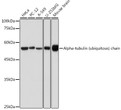| Post Translational Modifications | Some glutamate residues at the C-terminus are polyglutamylated, resulting in polyglutamate chains on the gamma-carboxyl group. Polyglutamylation plays a key role in microtubule severing by spastin (SPAST). SPAST preferentially recognizes and acts on microtubules decorated with short polyglutamate tails: severing activity by SPAST increases as the number of glutamates per tubulin rises from one to eight, but decreases beyond this glutamylation threshold. Glutamylation is also involved in cilia motility. Some glutamate residues at the C-terminus are monoglycylated but not polyglycylated due to the absence of functional TTLL10 in human. Monoglycylation is mainly limited to tubulin incorporated into cilia and flagella axonemes, which is required for their stability and maintenance. Flagella glycylation controls sperm motility. Both polyglutamylation and monoglycylation can coexist on the same protein on adjacent residues, and lowering glycylation levels increases polyglutamylation, and reciprocally. Acetylation of alpha chains at Lys-40 is located inside the microtubule lumen. This modification has been correlated with increased microtubule stability, intracellular transport and ciliary assembly. Methylation of alpha chains at Lys-40 is found in mitotic microtubules and is required for normal mitosis and cytokinesis contributing to genomic stability. Nitration of Tyr-451 is irreversible and interferes with normal dynein intracellular distribution. Undergoes a tyrosination/detyrosination cycle, the cyclic removal and re-addition of a C-terminal tyrosine residue by the enzymes tubulin tyrosine carboxypeptidase (MATCAP1/KIAA0895L, VASH1 or VASH2) and tubulin tyrosine ligase (TTL), respectively. Tubulin alpha-1B chain: Tyrosination promotes microtubule interaction with CAP-Gly domain-containing proteins such as CLIP1, CLIP2 and DCTN1. Tyrosination regulates the initiation of dynein-dynactin motility via interaction with DCTN1, which brings the dynein-dynactin complex into contact with microtubules. In neurons, tyrosinated tubulins mediate the initiation of retrograde vesicle transport. Detyrosinated tubulin alpha-1B chain: Detyrosination is involved in metaphase plate congression by guiding chromosomes during mitosis: detyrosination promotes interaction with CENPE, promoting pole-proximal transport of chromosomes toward the equator. Detyrosination increases microtubules-dependent mechanotransduction in dystrophic cardiac and skeletal muscle. In cardiomyocytes, detyrosinated microtubules are required to resist to contractile compression during contraction: detyrosination promotes association with desmin (DES) at force-generating sarcomeres, leading to buckled microtubules and mechanical resistance to contraction. |
| Function | Tubulin is the major constituent of microtubules, a cylinder consisting of laterally associated linear protofilaments composed of alpha- and beta-tubulin heterodimers. Microtubules grow by the addition of GTP-tubulin dimers to the microtubule end, where a stabilizing cap forms. Below the cap, tubulin dimers are in GDP-bound state, owing to GTPase activity of alpha-tubulin. |
| Protein Name | Tubulin Alpha-1b ChainAlpha-Tubulin UbiquitousTubulin K-Alpha-1Tubulin Alpha-Ubiquitous Chain Cleaved Into - Detyrosinated Tubulin Alpha-1b Chain |
| Database Links | Reactome: R-HSA-1445148Reactome: R-HSA-190840Reactome: R-HSA-190861Reactome: R-HSA-2132295Reactome: R-HSA-2467813Reactome: R-HSA-2500257Reactome: R-HSA-3371497Reactome: R-HSA-380320Reactome: R-HSA-389960Reactome: R-HSA-389977Reactome: R-HSA-437239Reactome: R-HSA-5610787Reactome: R-HSA-5617833Reactome: R-HSA-5620924Reactome: R-HSA-5626467Reactome: R-HSA-5663220Reactome: R-HSA-6807878Reactome: R-HSA-6811434Reactome: R-HSA-6811436Reactome: R-HSA-68877Reactome: R-HSA-8852276Reactome: R-HSA-8955332Reactome: R-HSA-9013407Reactome: R-HSA-9609690Reactome: R-HSA-9609736Reactome: R-HSA-9619483Reactome: R-HSA-9646399Reactome: R-HSA-9648025Reactome: R-HSA-9668328Reactome: R-HSA-983189Reactome: R-HSA-9833482 |
| Cellular Localisation | CytoplasmCytoskeleton |
| Alternative Antibody Names | Anti-Tubulin Alpha-1b Chain antibodyAnti-Alpha-Tubulin Ubiquitous antibodyAnti-Tubulin K-Alpha-1 antibodyAnti-Tubulin Alpha-Ubiquitous Chain Cleaved Into - Detyrosinated Tubulin Alpha-1b Chain antibodyAnti-TUBA1B antibody |
Information sourced from Uniprot.org














